Uliassi is located in Senigallia, in the province of Ancona (Le Marche), at the level of Florence and Zadar (Croatia). It is a town on the Adriatic coast with about 40,000 inhabitants, a lively tourist scene, a very active old town, and fine sandy beaches with rows and rows of deck chairs.

The restaurant, opened by Mauro Uliassi (Senigallia 1958) and his sister Catia Uliassi (Senigallia 1967) in 1990, is located right on the beach. It could be said that it was born as a beach bar next to the canal where the Misa river flows and next to the town’s fish market, with exceptional lobsters. The venue, with its characteristic white wood and facade tiles, looks attractive both day and night and throughout all seasons, whether it’s cold or hot, sunny, rainy, or windy.

Uliassi is a family restaurant. From the beginning, Mauro has been in the kitchen along with Mauro Paolini (Catia’s husband and Mauro’s lifelong friend), and Catia has been in the dining room. Currently, their respective sons, Filippo Uliassi and Gianmarco Paolini Uliassi, are also getting involved in the family business. In fact, Mauro and Catia were raised in the Bar Uliassi (in a neighborhood on the outskirts of Senigallia) run by their parents and now managed by their brother Walter, a former airline pilot.

Mauro is a chef who has not been trained in haute cuisine, although during the first years of the restaurant, he went to do some internships with chefs like Martín Berasategui, Ferran Adrià, Quique Dacosta, and Joan Roca. Similarly, Catia (passionate about design and painting and having spent 2 years at University) went to Enoteca Pinchiorri (Florence) and Dal Pescatore.

Brief Preliminary Notes on Game at Uliassi
Mauro Uliassi’s game menu aroused my curiosity but also many doubts, especially because I understood that he was recognized as a fish chef, but also because other Italian chefs had told me that game was completely prohibited in Italy and also because of serving a game menu in August by the sea.
I wondered if it would be farmed or wild; if it would be from Italy, specifically from Le Marche (remember that the Apennines are a few km from Senigallia) or from other countries; if it would be fresh, hung, or frozen; if there would be availability in August; what variety of truffle and from what origin they would use in the summer, etc. Therefore, I contacted Mauro to resolve all my doubts and ensure our choice.
Very kindly, Mauro explained to me that since 2016, there has been a law that prohibits serving game in restaurants throughout Europe (I understand he means the EU). It turns out that the only animals that can be used are partridges, pheasants, hares, mallard ducks, roe deer, deer, wood pigeons, which he says are found all year round (hares all year round?). Animals like woodcock (beccacce), common snipe (beccaccini Gallinago gallinago), thrush (tordi), blackbird (merli), common teal or teal (alzavola Anas crecca), grouse, etc., which they used to acquire in Scotland, are now completely prohibited. He says that Uliassi’s game can also be farmed or frozen, so it is not a problem for them to serve game in the summer as they can do a lot with what they find. Finally, he confirms that the black truffle (tuber aestivium) they serve in July and August is tuber aestivium.

Reading texts from “La scienza in cucina e l’arte di mangiar bene” (1891) by Pellegrino Artusi, a masterpiece of different regional cuisines of Italy, I see that in these latitudes, it seems that tons of thrushes, partridges, wood pigeons, hares… were cooked, but at some point, the custom was lost. I also read how Mauro remembers when he went hunting with his father. However, they soon stopped doing it, mainly out of pity for the animals and because the world was perhaps moving in another direction. But after a few years, he recovered that intimate memory of the tradition of Le Marche, which is not only lobsters and monkfish but also ducks and wood pigeons, and since 2001, he has been serving the game menu again.
Meal
As for the offer, there is the possibility of eating à la carte (minimum 3 dishes) or choosing one of the 4 menus (the Classic, the Easy Classic with 6 dishes, the Lab, and the Hunting).
We chose the Classic Menu 2023 and added some dishes from the Hunting Menu 2023, which I was also particularly interested in trying:
Loaker Di Fegato Grasso E Shot Di Kir Royale:

Loacker S.p.A. is an Italian confectionery company based in South Tyrol (Italy) and specialized in the production of wafers, chocolate, and derivative products.
An appetizer larger than I had imagined, I could take 3 bites. The filling inside (the foie with hazelnut praline) is very cold (without being ice cream) and is very good, but I don’t like the wafer/oblea, it seems like a host, the wafer of ice creams, and I would prefer another type of dough. An appetizer introduced by chef Michele Rocchi in 2006 when he returned from El Celler de Can Roca, where he got the idea of serving a bonbon as an amuse-bouche and thinking of the foie-hazelnut praline combination that he had already seen from Frédéric Bau of Valrhona. An appetizer that has become the emblematic appetizer of the house and that is also a bullinian appetizer for winking at a product of the food industry such as an Oreo, a Filipino, or a corte helado.
Accompanied by a small taste of Kir Royale (Prosecco with cassis, blackcurrant liqueur) that I wouldn’t need.
Smoked Herring Butter:
Foamy, it reminded me of the smell of caviar for its saltiness and smokiness. Very good.
Rosemary Oil:
Excellent, it had an incredible density, it looked like a puree. It’s a shame they don’t serve it on a white plate to be able to see it better, it must be beautiful. Finally, a haute cuisine restaurant that doesn’t hyper-filter everything!

Bread Plate (all made with sourdough):

- Corn grissini (made by themselves at the restaurant, they leave them in a fermentation chamber they have in the kitchen).
- 3 triangles with golden flax seeds and brown flax seeds: crispy and warm, the best and most suitable for the start of a meal. With one triangle per person, I would have enough.
- 2 slices of bread they call “pizza al formaggio”: it looked like butter bread, like a French brioche or milk bread, it was salty with a piece of Pecorino cheese from Le Marche. A very good bread, especially the piece you pick up from Pecorino, but I find it more for eating alone than for serving in a menu of these characteristics because it is too intense and “dirty” the palate.
- 1 slice of white bread with pieces of seaweed. A bread that, even though it is their recipe, is made by the bakery Pandefrà (I would say that the other breads are also from Pandefrà). The seaweed is not noticeable at all.
- 1 slice of bread made with an ancient grain. Correct, well made, but also not exceptional.
It is surprising that there are 3 triangles of one, 2 slices of another, and only 1 slice of each of the others. Later we could see that they keep replenishing them throughout the meal. I wouldn’t serve it like this, I would serve 1 of each to each person or serve them one by one and at the request of the diner. Also, as always when they serve so many types of bread in restaurants, it seems more to stuff than to enjoy. For my taste, it is not the moment to stuff myself with bread. And also, as always, they leave little time to try them.
Ricci Ghiacciati Mandarino Zafferanella:

An airy and crunchy black dough that could be squid ink with a slightly artificial texture and also not entirely well done, it was not that it was soaked, but the central part was softer, maybe it was something sought after.
On top, a “dough” of sea urchins from Puglia served cold, which without being a sea urchin granita turned out to be an ideal serving temperature because they melted/tempered immediately, generating a semifreddo and allowing them to release their delicious sea intensity. Delicious.
The yellow dots were zaferanella, a wild saffron from Monte Conero in Le Marche.
Finally, there was a yellow/orange dot at the base that was tangerine and gave it a bit too much citrus taste, nothing terrible, but the touch was noticeable. This creamy-textured, tangerine-flavored dot, which if I made it at home, I could only do with a Minipimer, is made with a rotary evaporator/distiller (a rotovap or rotavapor), a machine that extracts water from a liquid at about 30ºC (and I understand that in a vacuum) to obtain an extract/concentrate.
Gambero Rosso Buccia Di Arancio Zenzero Cervella Di Gambero E Cannella:

A red shrimp served raw and cold but at a very good temperature, with that touch of coldness that allowed it to release its mellowness.
The smell was more of citrus than shrimp, but they were very different from ours, softer, more fragrant, and less aggressive, they seemed just like the perfumes of oranges and lemons from Sicily and Garda. In contrast, in the mouth, the shrimp was noticeable, and the mixture of its sweetness with the sweetness of this exceptional Sicilian orange peel; also the touch of cinnamon and less ginger. A combination that a priori would seem totally wrong but carried out exquisitely. A dish that seems to me very representative of Mauro Uliassi’s brilliant way of combining flavors.
The head part was the “brain,” the slimy/purple/pink liver of the head served with the outermost part of the head without the “antennae” part.
All served with a touch of puffed quinoa that provided a very delicate crunchy touch.
The caliber of the shrimp (the tail eaten in 2 bites even though they serve it whole) could have been a bit bigger.
Sogliola Al Vapore Lattuga E Bergamotto Candito:
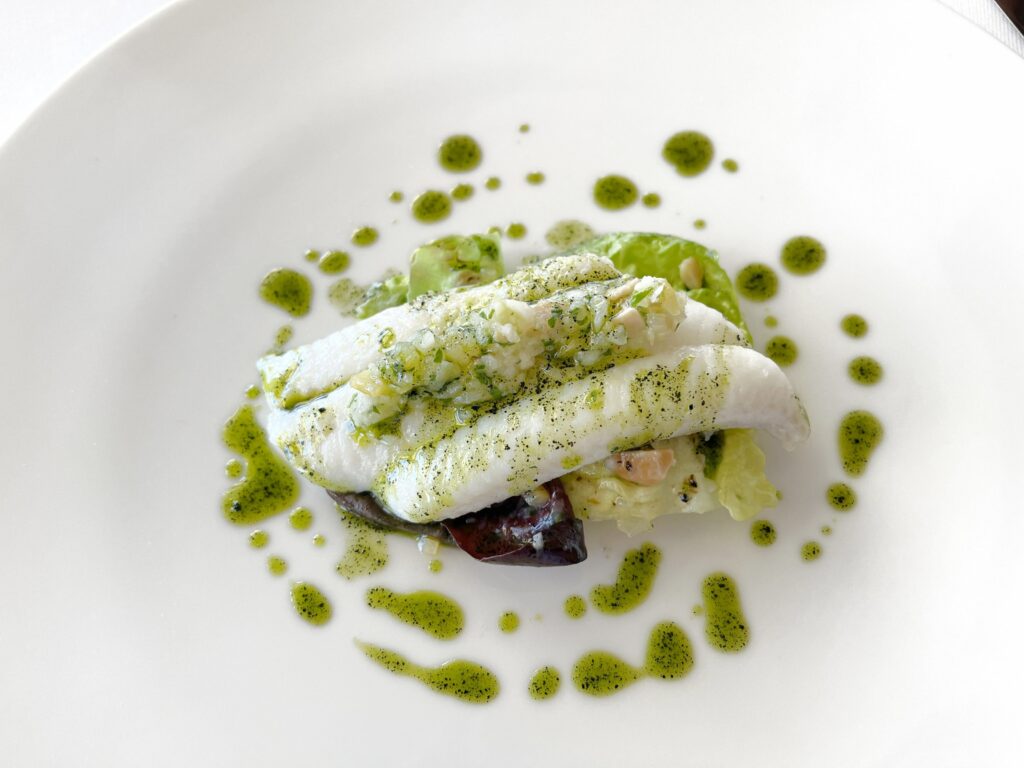
Although they don’t explain it when serving the dish, this is dedicated to Piergiorgio Parini, a chef born in 1977 who worked at Povero Diavolo* from 2006 to 2016, owned by Fausto Fratti in Torriana (Rimini, Emilia-Romagna), and left to start his project. He had 1* from 2011 to 2016.
A sole cooked in steam with good texture but served without skin and with a very mild taste, too neutral. A piece of a thick fillet of sole could perfectly be from a 15-2 kg sole.
The green sauce was made of algae. There are also cockles with pepper and lemon.
Perhaps in this case, the taste is a bit too citrusy (from bergamot), but the play of textures was very good.
The lettuce was delicious with the crunch of the hazelnut pieces, the citrus taste, and everything warm and juicy.
Rimini Fest. (Grilled baby squid skewer on charcoal and frozen citronette shot):
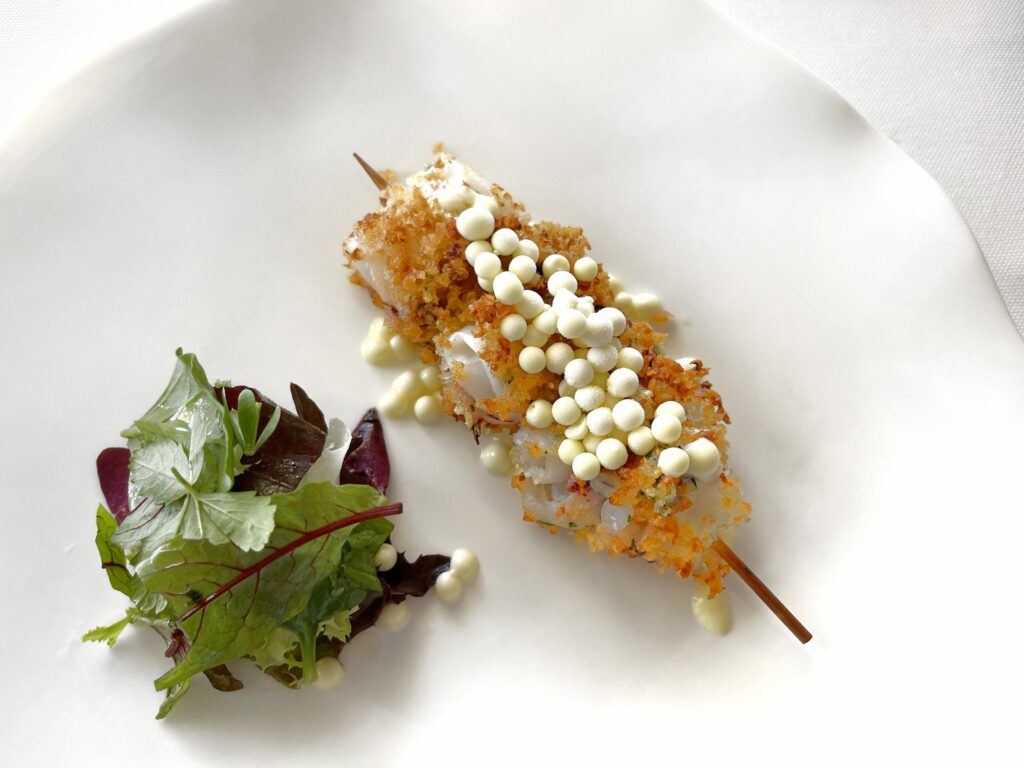
Although they also don’t explain it at the beginning, I ask why the name of the dish, and it turns out to be the memories that Mauro Uliassi has of Rimini from when he was a young chef and lived the party of this coastal city.
A delicious semifreddo. On one hand, the squid made on charcoal, cut into pieces with legs and all, served very hot and on top with bread crumbs fried that provided a frying and oily texture like a kind of Panko; and on the other hand, the white frozen balls of citronette sauce (a sauce based on olive oil and lemon juice) that melted on top. A delicious squid, what a fine texture!
In a separate bowl, a “gazpacho” of mango with cucumber, pineapple, and basil. A kind of very pleasant and refreshing chutney with a very mild spicy touch that must have come from a touch of shrirasha or some type of chili.
Ricciola E Scampi Alla Puttanesca (Raw amberjack, tomato, basil, anchovies, capers, arugula):
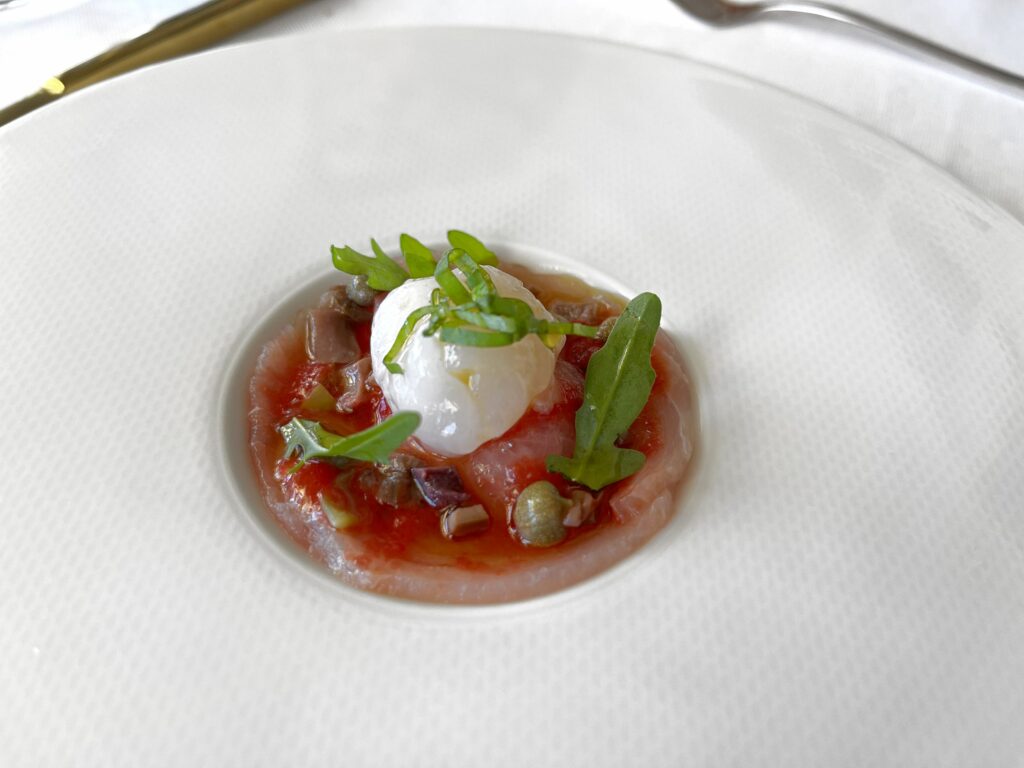
A raw amberjack and at the base, a very thin carpaccio of scampi.
Alla puttanesca, a typical sauce from southern Italy that usually accompanies pasta and is based on tomato, capers, anchovies, and olives.
A very fresh dish. It smells of basil, fish, and tomato, a smell of freshness. Inside it had 3 small croutons of fried bread. A bit small (to practically grab all in one bite) but delicious. The only dish that seemed excessively small to us.
Ossobuco Alla Marinara:

Served with a bell that they uncover in unison at the table.
Bone marrow (from veal) cooked in clam water and served with cod tripe, basil, and mustard seeds. He uses salted tripe (from salted cod, he doesn’t use fresh cod tripe) and cod from Iceland.
Served warm. The sauce was delicious with a taste of celery, parsley leaves, and the cooking water of the clams. Pleasant textures: the mellowness of the bone marrow (with a soft and fine texture and not very sticky), the mellowness of the tripe (with a more cartilaginous texture but stickier than the bone marrow due to its collagen), and the broth/sauce of clams (with a juicier and less sticky texture).
What a great idea to cook the bone marrow in the water of the clams!
A dish I particularly wanted to try, which I had imagined delicious and lived up to expectations both aromatically and in terms of the different mellownesses.
Pasta E Pomodoro Alla Hilde (infused with fig leaves):
Also served with a bell.

What a fig smell! What good pasta! Al dente, delicious. Flavor and aroma. Juicy. The fig perfume of the tomato sauce is incredible. It turns out that he uses fig leaves because aromatically they resemble the branches and leaves of tomato plants. Well, he infuses fig leaves with butter for 1 hour at 60ºC and then passes the pasta through a pan with this butter.
The tomato sauce is based on Pomodori del Piennolo del Vesuvio DOP, baked for 2 hours at 100ºC and then sieved through a sieve to obtain this dense, silky texture and lightly flavored with garlic and basil.
Although they don’t explain it, I had already read that it is a dish dedicated to Hilde Soliani, a perfumer and gastronome.
All the pasta they use is from Pietro Massi.
They change the type of bread plate for a blue and white Feeling’s plate by Sylvie Coquet.
Spaghetti Affumicati Vongole E Pomodorini Datterini Arrostiti:
Also served with a bell. A dish that they added for us as a courtesy.

When you eat the spaghetti, you notice the smokiness of having cooked them in a broth of smoked eel, they were delicious. There are three dehydrated tomatoes (by themselves in a drying room, some shelves inside a cabinet that works with hot air and a fan) and some clams the size of a cockle.
Very good, but it fills too much, and it is a dish that we would not have ordered, nor did it turn out to be excellent.
Mare O Selva:
They make you choose whether to make the sea dish or the forest dish. We make one of each so we can see both.
Sea: Grilled Seabass, White Wine Sauce, Morels, And Peaches:

A piece of sea bass loin made on the grill (the same one where they make the squid) served without the skin and with a crust of breadcrumbs (like the one on the squids but thicker). A white flour bread from Le Marche that they buy fresh, dry, and grate especially for these two dishes.
Served with two cubes of peach with a corky texture, they had made them on the grill, and they were dry and hard, I was surprised (rather negatively) by the texture. On top of these peach cubes, two fairly correct morels. The white wine, butter, and citrus sauce were delicious! Little taste of fish but very juicy, it fell apart in slices.
Forest: Roasted Wood Pigeon Alla Marchigiana And A Crostone With The Paté Of The Inner Parts:

I understand that we ate wood pigeon because Mauro told me that “colombacci sono piccioni selvatici detti anche palombe.”
The breast of an Italian wood pigeon served boneless (which is appreciated) but threaded on a skewer (which I don’t understand because I don’t eat it from there directly, and the first thing I did was remove the wooden stick and serve it on the plate). Below, a slightly sweet bread crouton stuffed with a paté of the wood pigeon’s inner parts sautéed with butter, cognac, and foie gras. As always, the toast with the inner parts, which seems like the secondary actor, is the best and most flavorful. There were also some cubes of orange.
They say that alla marchigiana is with lard and aromatic herbs like wild fennel.
The only game dish on the classic menu. We didn’t find the partridge. A very good dish but not exceptional.
Tartare Di Lepre Granita Di Ricci Di Mare Olio Di Ginepro:
The first of the 3 dishes I wanted to add.
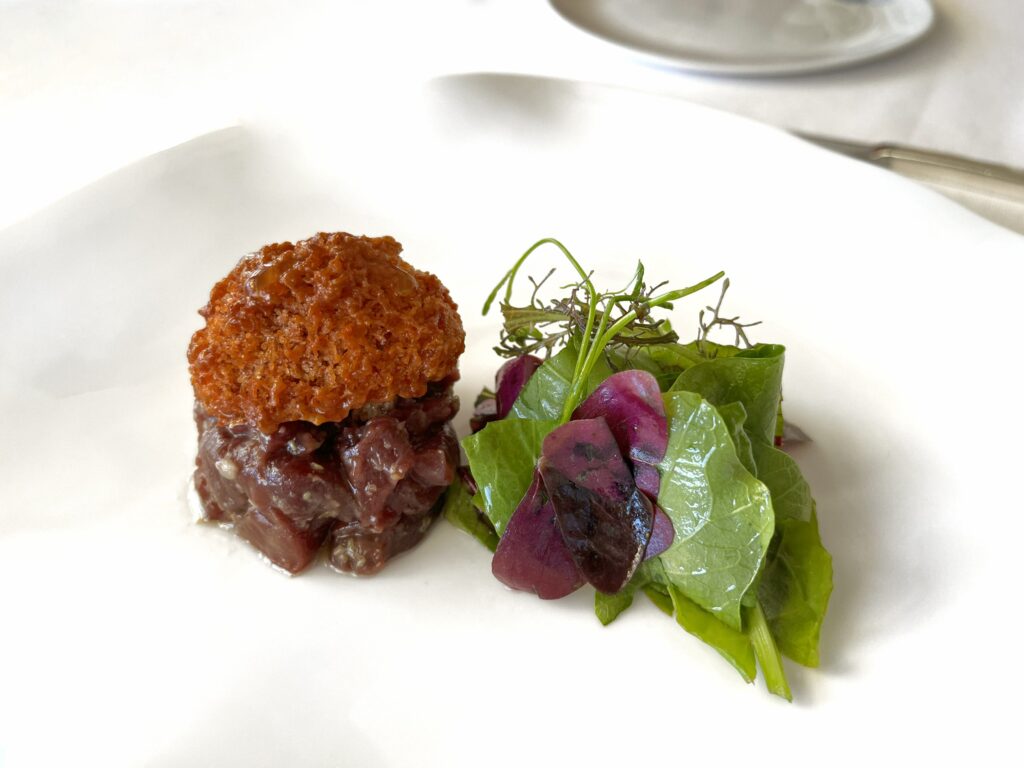
Wow, much more smell of sea urchin than the frozen sea urchin appetizer! Very intense sea urchins (sea, algae) and very fresh served on top of a raw and marinated hare from Italy with juniper oil that I didn’t even notice, a very tender hare that didn’t make any fuss. A surf and turf served semifreddo that melted very quickly. Two “ferrous” ingredients. Next to it, some leaves with vinegar. All in all, delicious.
Royale Di Germano Con Granita Di Lampone:
The second of the 3 dishes I wanted to add.

Well, as I thought from home, it was not a royale but à la royale. A variation of the hare à la royale, changing the hare for mallard duck, that is, a canard à la royale. A recipe that couldn’t be more French and made in the most classic way with the foie in the center and with blood in the dark sauce that coats the meat. It also had a piece of chocolate on top, gold also on top (unmistakable wink to Gualtiero Marchesi emphasizing the majesty of a royal recipe), and a coulis di lamponi (more than a granita), that is, a raspberry coulis with small whole cubes that didn’t fit at all (I never need these red fruits to eat game, I find that the touch of freshness and degreasing they provide detracts from the taste, I don’t like the game-fruit combination) and that fortunately was served on one side of the plate. The only slightly skimpy dish on the menu, but since they were additional dishes, it was reasonable.
Petto Di Fagianella Ostrica Olio Di Perilla E Semi Tostati:
The third of the 3 dishes I wanted to add.

Three thin slices of a pheasant breast that looked just like red meat (especially visually for its intense red color) with an oyster cut into three not integrated with the pheasant, and we would have liked to eat it colder. Tender and good meat, but it was not an exceptional dish.
Pre-Desserts:
Sorbetto Di Cabossa Mandorle Tostate Mango Meringa Fave Di Cacao:

A sorbet of cabossa, the mucilage, that is, the white part inside the fruit of the cocoa that contains the mucilage.
The white tears were small meringues.
The chocolate cubes looked like the cocoa bean pods they use at Lot to make a chocolate infusion.
Desserts:
Senigallia-Brest. (Vanilla chantilly cream, frozen cherries, and caramelized black olives):

A bike ride from Senigalia to Brest. A revision of the classic Paris-Brest cake (a kind of doughnut made with choux pastry similar to the dough of profiteroles, cut in half, and filled with chocolate or cream and hazelnut praline).
In this case, they were 2 pieces the size of a macaron or a profiterole. The dough was fried and tasted like churro, it was crunchy, very good. I would have liked to notice more the black olives that were dehydrated, caramelized, and dressed with oil and wild fennel. Very good, but I would serve one and that’s it, and as a petit four, since the size and format seem like it.
Small Pastry:

Frozen cherry filled with Maraschino liqueur and with a basil leaf on top.
White chocolate cube with coriander ice cream inside.
Dacquoise with coconut, white chocolate, and ginger.
Apricot and cardamom jelly.
Chocolate crumble with Peta-Zetas.
Cylinder of melon in osmosis with mint.
We Drank
Fontanasanta Nosiola 2020 from Foradori, a white wine with maceration on the skins made by Elisabetta Foradori, one of the most recognizable and appreciated wine producers in the Dolomites. A wine with that clear character that its Nosiola always has and that continues to surprise and delight us in a maceration on the skins. Ideal to accompany a whole menu of taste variations as marked as Uliassi’s.

To accompany both the duck à la royale and the pheasant breast with oyster, they served us a glass of Col d’Orcia 2018, a well-matured, balanced, and well-made Brunello di Montalcino, but it’s not our type of wine. A Sangiovese in Slavonian oak (east of Croatia).

Conclusions
I remember perfectly the first person who told me about Mauro Uliassi’s cuisine. It was the beloved Vedat Milor in 2010. 13 years later, I finally eat there.
Mauro Uliassi is a multifaceted chef with three distinct lines: fish (remember that it is always fresh fish that is matured by Moreno Cedroni), game, and this well-understood perspective of bullinian cuisine, demonstrating knowledge of both the techniques and the philosophy and essence of Ferran Adrià’s ideas, and moreover, knowing how to apply them to his cuisine (to the cuisine of his region and to his personal cuisine) with sense and wisdom in a very well-executed manner and under a figurative and not abstract cuisine.
I was impressed by his mastery of combining flavors. Especially the mastery he has of citrus fruits like oranges, tangerine, bergamot, oranges, or lemon juice for the citronette sauce, but also of ginger, juniper, or cinnamon. Or also the aromatic touch he indirectly brings to products, such as with the smoked herring butter, boiling the pasta in a broth of smoked eel, or cooking the bone marrow with the cooking water of the clams. Or the associations and taste harmonies he makes, like the ferrousness of the hare and the sea urchin.
For example, a priori, I think that combining a red shrimp with orange peel is a sacrilege typical of chefs who do not respect the product. But what a great dish the shrimp is! The flavor of these Sicilian oranges is unforgettable. Normally, orange peel brings an exogenous artificial taste that, in the worst case, can remind of bathroom detergents, masking flavors. But Uliassi’s oranges are perfume, they are not excessively acidic, they are balanced, delicious. Also, at first, it seems very daring to add saffron and tangerine to a sea urchin (the appetizer), but on the contrary, he manages to do it brilliantly. Also, at an aromatic and taste level, the fig leaf of his tomato sauce for the pasta e pomodoro alla Hilde dish is remarkable, unforgettable, and delicious.
From his cuisine, I highlight the fish dishes (especially the shrimp) and the surf and turf, very present also in Catalan cuisine (especially the delicious bone marrow with cod tripe), but I did not find the 100% game dishes exceptional, like the wood pigeon or the duck à la royale.
From his cuisine, I also highlight (for their abundance and mastery) the brilliantly thought-out serving temperatures, such as the whole bunch of semifreddo that he offered us, serving at different temperatures the different ingredients of a dish: one frozen (that always melts quickly, never felt like crushed ice as if it were for a mojito), another tempered, and finally, sometimes even a third hot element like a broth. Another also very bullinian aspect.
Also remarkable is the quality of the products. The sea urchins were excellent, very different from those of the Costa Brava or Galicia. I can’t even imagine what they must be like in Japan! The quality of the shrimp, the squids, and especially the quality and freshness of the secondary ingredients that accompany the dishes: citrus fruits, spices, herbs, leaves, fruits, etc.
Also, the size of the portions of all the dishes is very good. They serve enough quantity to be able to take some spoonfuls, giving the possibility to eat and enjoy the taste of the dish.
I also really liked the tempos between dish and dish, leaving time to enjoy the aftertaste, prepare the palate for the next dish, digest, and be able to enjoy the views, but without letting too much time pass, becoming tedious. There is no storytelling at all, and we were very comfortable; that said, they knew how to answer everything we asked, and if not, they consulted and ended up answering.
Finally, the service is also very good, impeccable. Apparently, it seems like a very solid team, both the kitchen and the dining room, which says a lot about the house and demonstrates loyalty and fidelity, dialogue, and good manners both on the part of the workers and on the part of the Uliassis. Not to mention Ivano Coppari, the sommelier, who has been working at the house since its opening 33 years ago, and most of the staff has been at the house for 10 or 20 years, where young people like Gabriel, a very young waiter who was from Senigalia itself and who also attended us perfectly, are joining.
Although they had the windows open and at some point, it was a bit hot, the table and space are very comfortable.
Some decorative elements are surprising (between kitschy and a bit excessive or even vulgar), such as the Fornarina plates served at the beginning of the meal and removed immediately, the jellyfish on the table, the candlestick-vase, the gold knives, the traffic mirrors (which more than a work of art could be some memory of Mauro’s festive era in Rimini), or the red FAKE table on the terrace, among others.

I asked to see the kitchen, and chef Luca Musella (also from Senigalia), who has been working at Uliassi for 6 years, showed it to us and explained it in detail, answering all our questions with enthusiasm and total predisposition, and dedicating his time to us. As for the space, it is distributed by sections: starters (appetizers/antipasti), raw, entry of goods, and pastry. At first, I noticed that it has gas: 10 burners for the starters and a beautiful old red and gold Fourneaux Molteni stove from the 1923 line for the seconds. It also has 2 griddles for the starters and 1 for the seconds, 1 charcoal grill, and 1 salamander for the starters.
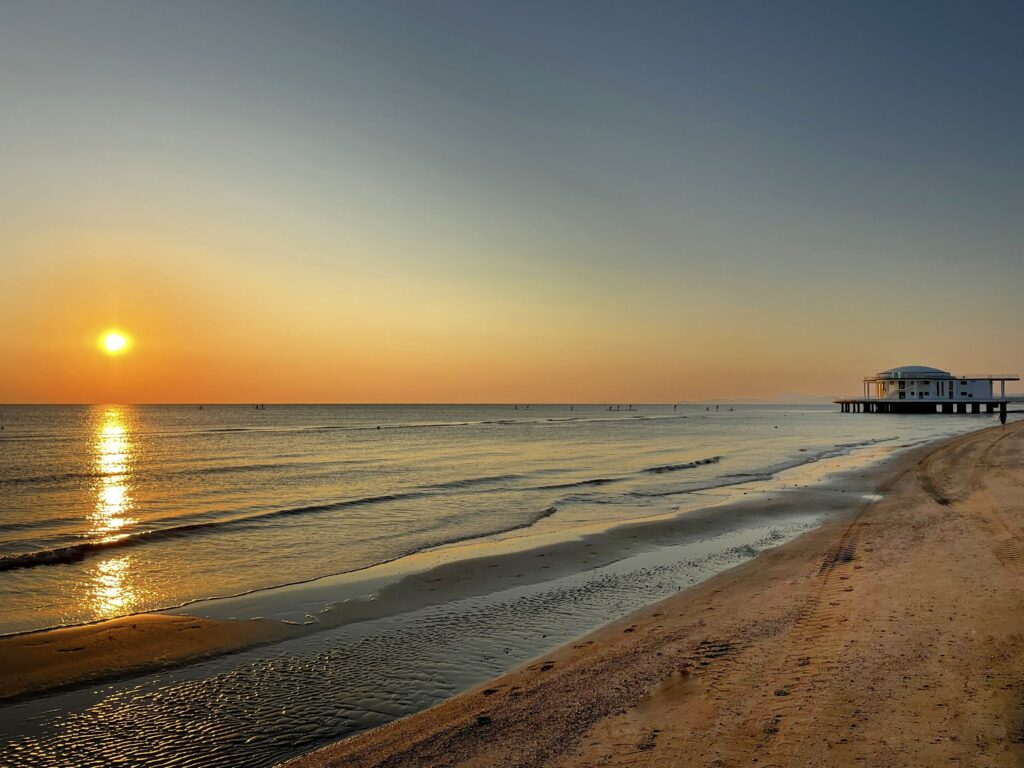
In summary, even though Mauro Uliassi and Mauro Paolini were not present, we had a very good meal. The welcome from Catia Uliassi and her dining room and kitchen team were enough not to feel disappointed and to leave me wanting to return to be able to try the Lab menu and dishes like his “Brodetto all’anconeta,” the “Rombo alla plancha calamaretti salsa bruciata di cipollotti e peperoni,” the “Grouse semi tostati ostrica e succo di grouse,” the lamb fuori di testa, the “Beccaccia per 6 beccacce,” or his “cassata” dessert, which are samples of his cuisine, an identity cuisine with its own character and regional.





